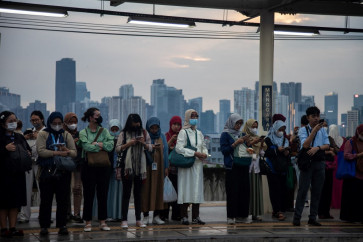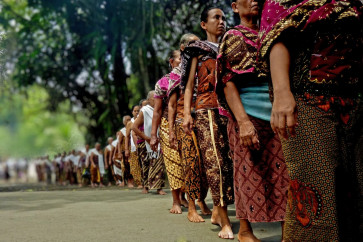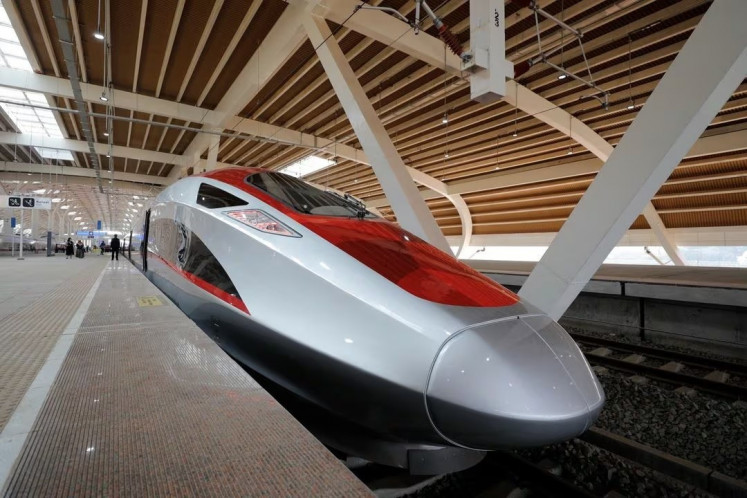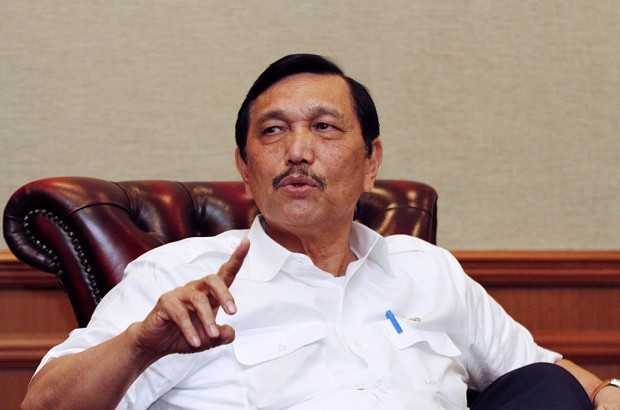Popular Reads
Top Results
Can't find what you're looking for?
View all search resultsPopular Reads
Top Results
Can't find what you're looking for?
View all search resultsGovt urged to promote 'songket' after success with batik
Artistic fashion: Proudly wearing songket (traditionally woven textile), participants join a parade during the Sawahlunto Songket Carnival in Sawahlunto, West Sumatra
Change text size
Gift Premium Articles
to Anyone
 Artistic fashion: Proudly wearing songket (traditionally woven textile), participants join a parade during the Sawahlunto Songket Carnival in Sawahlunto, West Sumatra. Songket producers have urged the government to promote the textile as much as it has been promoting batik.(JP/Syofiardi Bachyul Jb) (traditionally woven textile), participants join a parade during the Sawahlunto Songket Carnival in Sawahlunto, West Sumatra. Songket producers have urged the government to promote the textile as much as it has been promoting batik.(JP/Syofiardi Bachyul Jb)
Artistic fashion: Proudly wearing songket (traditionally woven textile), participants join a parade during the Sawahlunto Songket Carnival in Sawahlunto, West Sumatra. Songket producers have urged the government to promote the textile as much as it has been promoting batik.(JP/Syofiardi Bachyul Jb) (traditionally woven textile), participants join a parade during the Sawahlunto Songket Carnival in Sawahlunto, West Sumatra. Songket producers have urged the government to promote the textile as much as it has been promoting batik.(JP/Syofiardi Bachyul Jb)
A
span class="caption">Artistic fashion: Proudly wearing songket (traditionally woven textile), participants join a parade during the Sawahlunto Songket Carnival in Sawahlunto, West Sumatra. Songket producers have urged the government to promote the textile as much as it has been promoting batik.(JP/Syofiardi Bachyul Jb)
Following its success in promoting batik across the archipelago as Indonesia's special cloth, the government has been urged to do the same with songket (traditionally woven textile) as another kind of cloth unique to Indonesia.
The call was expressed by Swiss architect Bernhard Bart of Loom Sumatra Songket Studio during a songket exhibition held in Sawahlunto city, West Sumatra, on Friday.
'The government should give its full attention to songket, making it popular as an Indonesian cloth, just like batik,' said Bart, who has been seriously studying Minangkabau songket and collecting data needed to develop songket's traditional motifs since 1996.
Together with his West Sumatran partner, Bart and his wife Erika in 2005 established a songket woven studio in Ampek Angket district, Agam regency, and revitalized old songket of the Minangkabau style.
So far he has succeeded in making replicas of some 25 traditional songket scarfs from different weaving places.
Bart said that in 1996 he learned that the songket in West Sumatra was of very low quality and found that only a few artisans counted on songket-making as their chief
livelihood.
Presently, thanks to efforts from the government and some songket makers, the quality has significantly improved. 'This needs to be further pushed to make it popular across Indonesia, so that one day it can be exported,' he said.
What needed to be considered, according to Bart, was how to produce affordable songket of high quality that was also comfortable to wear.
He said it was important to offer a wide variety of songket ranging from the cheapest to the most expensive in price according to their respective quality.
He also suggested artisans gather up the guts to get out of the traditional grip of history and come up with new innovations in the choice of threads and the combination of motifs.
He expressed appreciation to the Sawahlunto city administration for conducting the songket carnival and holding exhibitions with participants from tens of songket studios across West Sumatra.
The carnival, held on Friday, was recorded in the Indonesian Museum of Records because 17,290 people wore Silungkang songket during the event.
Silungkang, in Sawahlunto, is one of three renowned songket production centers in West Sumatra. The other two are Pandai Sikek and Koto Gadang in Agam regency.
In 1910 Silungkang songket producer Ande Baensa was invited to Brussels, Belgium, to participate in a songket exhibition and received an award from the Kingdom of Belgium for his participation.
Sawahlunto Mayor Ali Yusuf said that during the Dutch colonial era Silungkang songket products were also exhibited in the Netherlands. He promised that songket would be once again exhibited in a number of world cities.
'We are preparing for songket to penetrate the European markets and a number of cities in the US,' said Ali, adding that Silungkang songket products had already met the export quality standard.
Sawahlunto is home to some 900 songket artisans. Each is capable of producing a piece of songket cloth in two days priced between Rp 150,000 (US$10) to Rp 200,000 per piece.
Small and medium industry director general Euis Saedah said songket had an opportunity to compete in the international market because of its historical value and its inherent beauty.
'Songket is unique and it is an art product,' said Euis after attending the carnival on Friday.
She said Silungkang songket would be put in the network of Muslim fashion producer Shafira for an exhibition in Paris and New York.
Besides West Sumatra, other places throughout the archipelago, especially outside of Java, are also known for their songket making traditions, such as those found in North Sumatra, South Kalimantan, South Sulawesi and East Nusa Tenggara.









